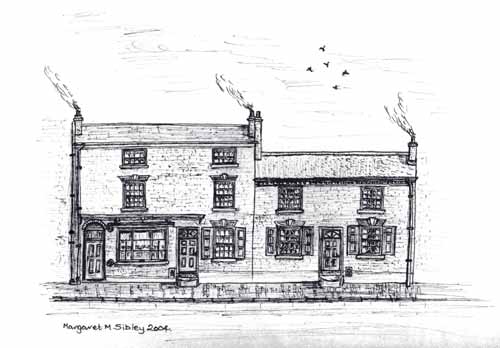![]()

The drawing shows number 7 Union Street as it probably was just after it was built. The papers for the development of Market Street show Butlers to have been built about 1810, although it is possible the western (right hand) portion may be older and have been an outbuilding or cottage to the Needham’s land on which the building stands. The dog tooth coggins under the roof line and which are not present on the higher building suggest the smaller building may be older.
The elaborate stuccoed window lintels presumably were to ‘add a bit of class’ and reflect those adorning number 1 and also the cottage next to the post office in Long Acre. If the western cottage had been built earlier, the lintels could have been added for symmetry, although the common ownership that would suggest was not the case. Thus perhaps the lintels are a clue to the buildings actually being contemporary with each other.
The western portion is thought originally to have been a separate cottage - there may have been two narrow cottages, but only one is shown as being perhaps more likely as there does not seem room for two windows and two doors. The shop was originally a bakery owned by Samuel Pilgrim; some fittings from that era remain on an upper storey inside (notably a sack chute). In the very late 1890s the shop became a butchers owned by Joseph Walker, who moved his butchery business from Long Acre where he was licensee of the Wheatsheaf and a butcher. He was succeeded in 1935 by Joseph Butler. It ceased to be a butchers in 1989.
Old photographs show the position of the original domestic front door (now moved to become the back door to the building), the original domestic window and the canopy that stretched over the extended shop window area. The drawing shows a shorter canopy; there may well not have been one at all at first, as the canopy could have been added when the shop became a butchers and meat was to be hung out side. This would have afforded protection from the weather for the joints of meat and other produce hanging from the still visible hooks underneath it. From 1900 until 1951 cattle were driven to their fate through the gateway on the far right and into to the slaughterhouse in the rear yard. As the shop did not become a butchers until the late 1900s this gateway would have been a late alteration.
The present owner remembers a four storey building to the East (left, now the Wool Shop) and a smaller cottage to the west (right) now replaced by modern shops and offices. The four storey building was most probably the boarding house, with 17 lodgers recorded in the 1841 census. Such a large building would have been eminently suitable for the temporary workhouse accommodation described in Street Names. The now demolished cottage to the west would have been the second of Samuel Pilgrims’ houses or that of Richard Pilgrim the painter, depending on whether the western portion of Butlers was one or two cottages.
